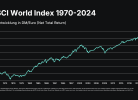By MITCH ZACKS
We’re in a moment in history where few things seem normal, and there are many unknowns. This dynamic also means that several economic data points (which I’ll detail below) have also moved into ‘first-time-in-history’ territory, which may seem worrisome, but I will argue is not inherently negative. This week’s column will take a look at five interesting facts about the stock market and the economy today, while explaining why each one matters.
Fact #1: Altogether, the balance sheets at global central banks are growing at a 33% year-over-year pace. Here in the U.S. the Fed’s measure of money supply (M2) is growing at a 23% year-over-year pace.
M2 Money Supply Year-Over-Year Growth in the U.S.

Source: Federal Reserve Bank of St. Louis
Why this matters: The world is awash in liquidity, and central banks show few signs of letting up. If anything, central banks are likely to expand balance sheets even further in the coming months and quarters, which by itself is a bullish indicator, in my view. I have written before that this liquidity backdrop makes it difficult to be bearish, even if economic data remains weak in the near-term. The well-known phrase “don’t fight the Fed” applies.
Fact #2: During this ongoing market rally, the five biggest U.S. companies have seen their valuations climb to over 30x earnings. The spread between these five companies’ valuations, and the remaining companies in the S&P 500’s valuations, is wide and getting wider.
Why this matters: Many readers have likely seen the stat-lines before – the biggest U.S. companies, largely in the realm of technology, are disproportionately driving returns for the S&P 500. But the real reason these runaway valuations matter, in my view, is that the markets tend to mean revert over time. The last time the spread between the biggest companies’ valuations and the remaining S&P 500 companies’ valuations were this wide was in 2018. A major market correction that year narrowed the gap quickly.
Fact #3: Five of the largest companies in the S&P 500 – MSFT (Microsoft), AMZN (Amazon), GOOG (Google) & FB (Facebook) – make up nearly 25% or a quarter of the S&P 500’s total market cap. For the Russell 1000 Growth Index, these five stocks make up 34% of the index. For the NASDAQ, the number swings up to 48%!
Why this matters: Though it may feel unsustainable for a handful of companies to account for such a large percentage of an index’s market capitalization, I would note that a correction may ultimately lead to a rotation of capital from high valuation names to low valuation names. In other words, all ships do not necessarily have to sink if the biggest names undergo some selling pressure.
Fact #4: Even though the S&P 500 is nearing new all-time highs, only about a quarter of stocks in the index are within 5% of their own all-time highs. Nearly half of index constituents are over 20% from their all-time highs.
Why this matters: The takeaway here is similar to the takeaway above, in that a small percentage of stocks have been driving total return for the index. I expect some mean reversion moving forward, and thus believe a diversified approach is very important in the current environment.
Fact 5: At the beginning of earnings season, S&P 500 earnings were forecast to decline -43%. The actual outcome has been better than expected.
Why this matters: Anytime outcomes are better than expectations – especially when it comes to earnings – stock prices tend to go up. I think it is fair to assess that better-than-expected earnings have been contributing significantly to the current rally. Total earnings (or aggregate net income) for the 445 S&P 500 members that have reported as of this writing are down -34.8% on -10.9% lower revenues. But 80.2% of these 445 index members have beaten consensus EPS estimates and the corresponding revenue beats percentage is 63.1%, with a blended beats percentage of 56.4%.
Bottom Line for Investors
Hopefully readers find these data points and takeaways helpful in making sense of the current market. The bottom line here may be that in a world awash in liquidity and with companies doing a little better than expected, the case for a well-diversified portfolio is paramount. In short, now is not the time to go all-in on just the biggest U.S. tech companies, nor is it the time to bet against the U.S. economy, in my view.
Wenn du keinen Beitrag mehr verpassen willst, dann bestell doch einfach den Newsletter! So wirst du jedes Mal informiert, wenn ein neuer Beitrag erscheint!







